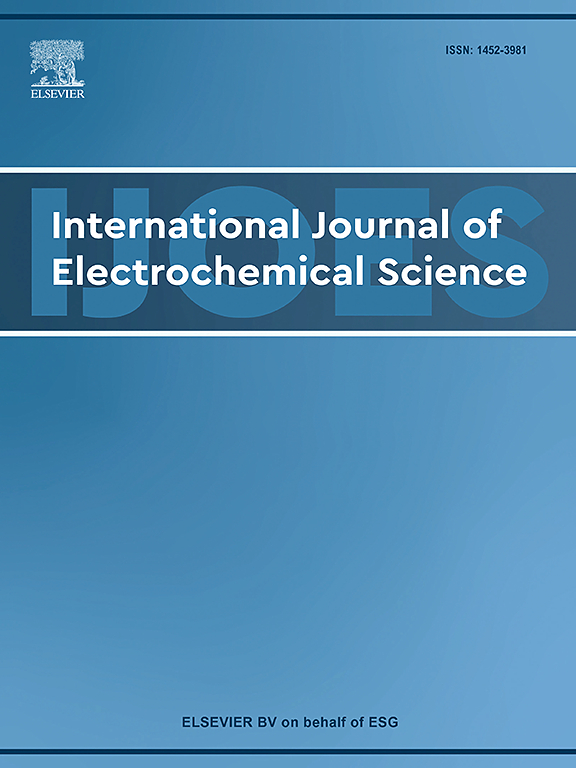Enhanced oxygen evolution reaction activity of iridium oxide supported on tantalum-doped tin oxide for acidic water electrolysis
IF 1.3
4区 化学
Q4 ELECTROCHEMISTRY
International Journal of Electrochemical Science
Pub Date : 2025-04-24
DOI:10.1016/j.ijoes.2025.101045
引用次数: 0
Abstract
In the research process of proton exchange membrane electrolysis, Ir-based catalysts exhibit sluggish dynamics of reaction and the poor durability in strongly acidic medium, as well as the high cost greatly limit their commercialization. In this paper, in order to decrease the Ir amount and improve precious metal utilization, Ta-doped tin oxide (SnO2) was prepared by sol-gel method in this paper as a support and loaded with iridium dioxide (IrO2). The results indicate that the Ta doping increased conductivity of SnO2 by two orders of magnitude and inhibited particle size growth. The introduction of 2Ta-SnO2 supports improved the electric charge transfer dynamics during the catalytic reaction process, and the mass activity of the 40 wt% IrO2/2Ta-SnO2 catalyst reached 835.39 A g−1 IrO2, which was 3.6 times higher than that of commercial IrO2. The overpotential of the 40 wt% IrO2/2Ta-SnO2 catalyst was 264 mV at a current density of 10 mA cm−2, which is due to the prominent dispersion effect of the support as well as the interaction of the support surface with the active substance. Its stability is better than that of commercial IrO2 in a stability test over 20,000 s. Therefore, Ta-doped SnO2 supported IrO2 catalysts have a promising application by reducing the cost of precious metal catalysts and enhancing the electrocatalytic properties of OER catalysts.
掺钽氧化锡负载氧化铱在酸性水电解中的析氧活性增强
在质子交换膜电解的研究过程中,基于ir的催化剂在强酸性介质中反应动力学缓慢,耐久性差,且成本高,极大地限制了其商业化。为了减少Ir用量,提高贵金属的利用率,本文采用溶胶-凝胶法制备了掺杂ta的氧化锡(SnO2)作为载体,并负载二氧化铱(IrO2)。结果表明,Ta的掺杂使SnO2的电导率提高了两个数量级,并抑制了SnO2的粒径增长。2Ta-SnO2载体的引入改善了催化反应过程中的电荷转移动力学,40 wt% IrO2/2Ta-SnO2催化剂的质量活度达到835.39 A g−1 IrO2,是工业IrO2的3.6倍。40 wt% IrO2/2Ta-SnO2催化剂在电流密度为10 mA cm−2时的过电位为264 mV,这是由于载体的分散作用和载体表面与活性物质的相互作用所致。在超过20,000 s的稳定性测试中,其稳定性优于商用IrO2。因此,通过降低贵金属催化剂的成本和提高OER催化剂的电催化性能,ta掺杂SnO2负载IrO2催化剂具有很好的应用前景。
本文章由计算机程序翻译,如有差异,请以英文原文为准。
求助全文
约1分钟内获得全文
求助全文
来源期刊
CiteScore
3.00
自引率
20.00%
发文量
714
审稿时长
2.6 months
期刊介绍:
International Journal of Electrochemical Science is a peer-reviewed, open access journal that publishes original research articles, short communications as well as review articles in all areas of electrochemistry: Scope - Theoretical and Computational Electrochemistry - Processes on Electrodes - Electroanalytical Chemistry and Sensor Science - Corrosion - Electrochemical Energy Conversion and Storage - Electrochemical Engineering - Coatings - Electrochemical Synthesis - Bioelectrochemistry - Molecular Electrochemistry

 求助内容:
求助内容: 应助结果提醒方式:
应助结果提醒方式:


